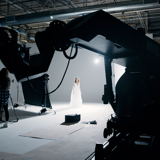Though we are known primarily as a photography studio, TRG Reality produces a lot of video as well. On a video shoot, you can expect to see numerous people hustling and bustling about, taking care of all that needs to be accomplished for the day’s work. But who are these people, and what do they do? Moreover, if you are on set during a video shoot, and you have a question about where a prop should be moved, the lighting, the talent’s outfit, lunch, etc., whom do you ask? Here is a list of all of the people, as well as a description of their responsibilities, you may find on your next video shoot with TRG.
OPERATIONS
Director: The Director’s job is all about execution. He or she oversees the entire shoot, ensuring the talent is doing exactly what the Art Director wants for the shoot. They tell the actors how to perform their lines, they dictate the positions of the cameras and lighting, and they manage the timing of the special effects; in short, they ensure the plot line is moving in all of the right directions at all of the right times. When he or she calls “action,” the magic really begins.
Assistant Director: The AD’s responsibilities entail stepping in to take care of what the director needs. If the director can’t be on set, the AD can take over since he/she is essentially the right-hand of director. He or she keeps everyone on schedule, and takes care of those on-set jobs that allow the director to focus solely on the talent and what is happening in the shoot.
Production Manager: This is the person who essentially coordinates everything for the shoot and presses the “go button.” He or she will organize everything for the pre-shoot preparations, making sure all is ready for day one of shooting. The Production Manager also hires the talent and makes sure the budget is under control. The PM wants to ensure everything runs as smoothly as possible on shoot day. You will often see the PM working directly with the assistant director.
CAMERAS AND LIGHTING
Director of Photography: The Director of Photography (referred to as the DoP) is in charge of the camera and lighting crews on set. He/she will sometimes also act as the camera operator. The role of the DoP is to set up the camera and lighting equipment used for the shoot. They will work closely with the director to ensure the shots look exactly the way they need to be. It is the role of the DoP to make sure the story that needs to be told is being visualized through the lens.
Camera Operator: The Camera Operator does exactly what you think: operates the camera. He or she is in charge of capturing all of the shots needed for the video. There can be more than one Camera Operator on set; it all depends on the size and scope of the project.
Grips: The Grips are responsible for all of the equipment set up, making sure all of the batteries are charged, that items are switched in and out on set when needed, etc. On larger productions, there are levels within the Grips, including Gaffers, Best Boy, etc., and each has a very specific job they are to manage, such as operating a specific light, setting up a specific prop, and so on. In short, Grips cover all of the logistics of the smaller aspects of a shoot.
Digital Media Manager: This person’s role is to organize all of the footage taken at the end of the day. They are to make sure that everything is backed up and organized for editor. They handle all file management of the footage, and transfer it from shooting to editing.
Location Manager: The role of the Location Manager is to scout possible locations, secure permits when needed, and negotiate contracts with home owners/business owners. He or she will also coordinate where people are going to park the day(s) of the shoot, where trash needs to be thrown out, where the restrooms are located, and so on. In a nutshell, the Location Manager needs to make sure that the location is suitable to shoot in and that we are equipped with all of the necessities.
SOUND
Production Sound Mixer: Capturing all of the audio for the shoot is the responsibility of the Production Sound Mixer. They must ensure there is no background noise in the shots, and that we have all that we need. They must make sure the sound is the right quality, and they will provide the mixed audio files to editor.
Sound Technician: The Sound Tech. is in charge of running the mics, and making sure everything is wired up correctly. In short, he/she is responsible for all of the hands-on work with the sound equipment.
APPEARANCE AND AUXILIARY
Makeup Artist and Hair Stylist: The Makeup Artist will apply makeup to the talent, including special effects makeup if need be, and the hair stylist will trim, tease, color, curl, etc. the hair for all of the actors on set. Both take direction from the Art Director as to what the overall look and feel should be for the shoot.
Wardrobe Stylist: This person is responsible for purchasing the wardrobe, and ensuring it is a cohesive collection that fits the look and feel of the project. He or she will also style while on set for the shoot.
Art Director: It is the role of the AD to guide the director, the set stylist, and the film crew. He or she is in charge of all of the creative aspects of the film; they ensure the overall feel and look of the shoot is on point.
Set Designer/Stylist: The Set Designer or Stylist is in charge of creating the look of the rooms/set that will be used in the shoot. They will draw sketches prior to construction, they will be on set the day of the shoot to reorganize props as last minute adjustments may be necessary. In short, it is their responsibility to make sure the stage picture looks its best during the shoot.
Prop Master: The role of the Prop Master is to assist the set stylist. He or she will make sure the stylist has everything they need for the set design. They need to be able to procure props quickly and efficiently.
Craft Services: These folks are responsible for snacks, drinks, and anything else the “craftsmen” may need while on set. Note that Craft Services is not responsible for catered meals, but they do provide pretty much everything else.
The list above is truly a baseline of what you may find on a TRG video shoot. Depending on the size of the project, the type of shoot, the budget, and the location, all of these factors greatly determine the makeup of the crew. In addition to the above positions, you may find that you also need to hire a child wrangler, pet wrangler, writer, music director, executive producer, production assistant, script supervisor, casting director, multiple camera people, electricians, construction, choreographer, runner, a visual effects supervisor, and so on. The amount of people and their responsibilities goes on and on, but don’t let this overwhelm you. When you come to TRG to plan your next shoot, we will make sure all of the right people are staffed on the project set taking care of business, and producing the best quality video for your needs.



